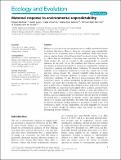Files in this item
Maternal response to environmental unpredictability
Item metadata
| dc.contributor.author | Barbosa, Miguel | |
| dc.contributor.author | Lopes, Isabel | |
| dc.contributor.author | Venâncio, Catia | |
| dc.contributor.author | Janeiro Silva, Maria Joao | |
| dc.contributor.author | Morrissey, Michael Blair | |
| dc.contributor.author | Soares, Amadeu M.V.M. | |
| dc.date.accessioned | 2015-10-06T09:10:00Z | |
| dc.date.available | 2015-10-06T09:10:00Z | |
| dc.date.issued | 2015 | |
| dc.identifier | 221849954 | |
| dc.identifier | 1530a7cd-9b34-4b27-8a55-9fdc51cf5f87 | |
| dc.identifier | 000363731500007 | |
| dc.identifier | 84982211632 | |
| dc.identifier.citation | Barbosa , M , Lopes , I , Venâncio , C , Janeiro Silva , M J , Morrissey , M B & Soares , A M V M 2015 , ' Maternal response to environmental unpredictability ' , Ecology and Evolution , vol. Early view . https://doi.org/10.1002/ece3.1723 | en |
| dc.identifier.issn | 2045-7758 | |
| dc.identifier.other | Bibtex: urn:e3f6ba3ca1de5186523119928adbdd0b | |
| dc.identifier.other | ORCID: /0000-0003-0327-9580/work/60630779 | |
| dc.identifier.uri | https://hdl.handle.net/10023/7610 | |
| dc.description | This study was funded by a postdoctoral fellowship to MB (SFRH/BPD/82259/2011) and with a “Bolsista CAPES/BRASIL,” (Project A058/2013) to AMVMS. | en |
| dc.description.abstract | Mothers are expected to use environmental cues to modify maternal investment to optimize their fitness. However, when the environment varies unpredictably, cues may not be an accurate proxy of future conditions. Under such circumstances, selection favors a diversifying maternal investment strategy. While there is evidence that the environment is becoming more uncertain, the extent to which mothers are able to respond to this unpredictability is generally unknown. In this study, we test the hypothesis that Daphnia magna increase the variance in maternal investment in response to unpredictable variation in temperature consistent with global change predictions. We detected significant variability across temperature treatments in brood size, neonate size at birth, and time between broods. The estimated variability within-brood size was higher (albeit not statistically significant) in mothers reared in unpredictable temperature conditions. We also detected a cross-generational effect with the temperature history of mothers modulating the phenotypic response of F1's. Notably, our results diverged from the prediction that increased variability poses a greater risk to organisms than changes in mean temperature. Increased unpredictability in temperature had negligible effects on fitness-correlated traits. Mothers in the unpredictable treatment, survived as long, and produced as many F1's during lifetime as those produced in the most fecund treatment. Further, increased unpredictability in temperature did not affect the probability of survival of F1's. Collectively, we provide evidence that daphnia respond effectively to thermal unpredictability. But rather than increasing the variance in maternal investment, daphnia respond to uncertainty by being a jack of all temperatures, master of none. Importantly, our study highlights the essential need to examine changes in variances rather than merely on means, when investigating maternal responses. | |
| dc.format.extent | 316847 | |
| dc.language.iso | eng | |
| dc.relation.ispartof | Ecology and Evolution | en |
| dc.subject | Fitness | en |
| dc.subject | Jack of all trades | en |
| dc.subject | Maternal Investment | en |
| dc.subject | Trans-generational effects | en |
| dc.subject | Unpredictability | en |
| dc.subject | Variance | en |
| dc.subject | QH301 Biology | en |
| dc.subject.lcc | QH301 | en |
| dc.title | Maternal response to environmental unpredictability | en |
| dc.type | Journal article | en |
| dc.contributor.institution | University of St Andrews. School of Biology | en |
| dc.contributor.institution | University of St Andrews. Centre for Biological Diversity | en |
| dc.identifier.doi | 10.1002/ece3.1723 | |
| dc.description.status | Peer reviewed | en |
| dc.identifier.url | http://onlinelibrary.wiley.com/doi/10.1002/ece3.1723/suppinfo | en |
This item appears in the following Collection(s)
Items in the St Andrews Research Repository are protected by copyright, with all rights reserved, unless otherwise indicated.

